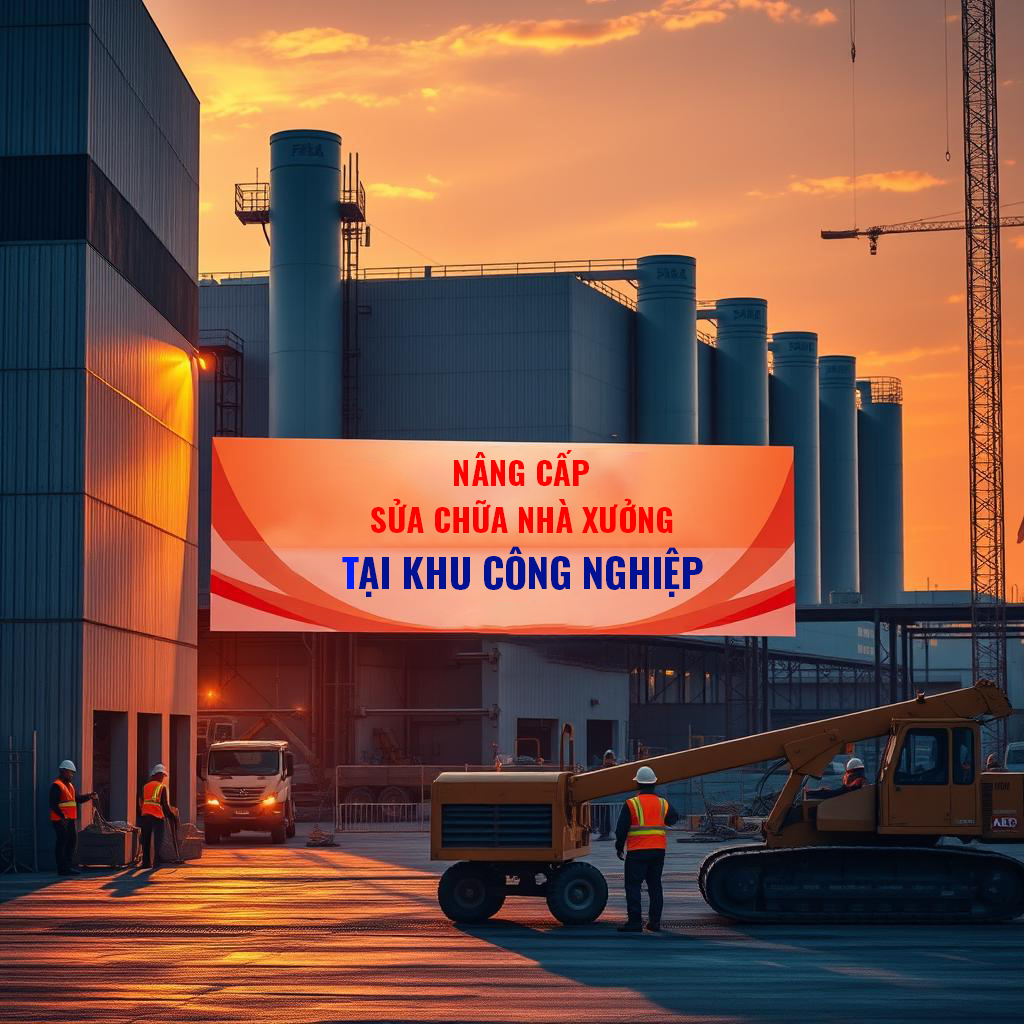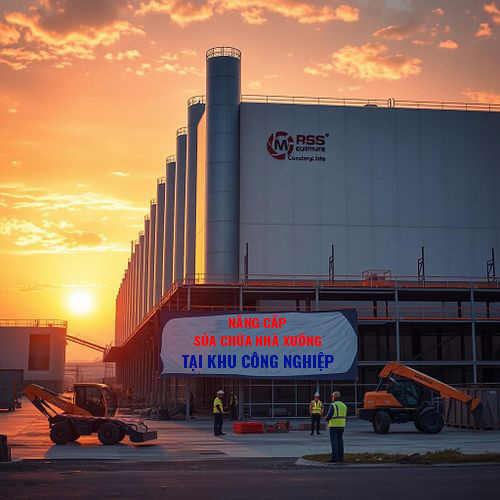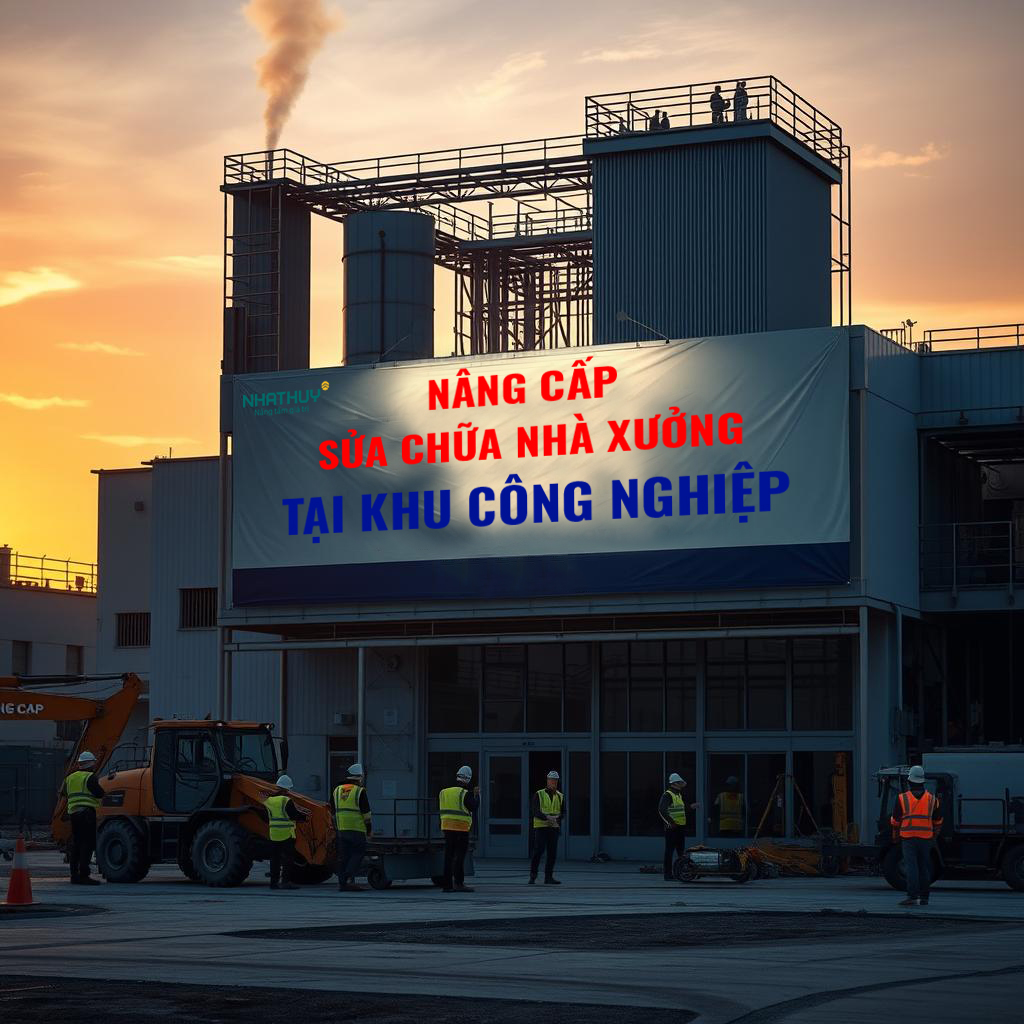In recent years, industrial parks across Vietnam such as Bình Dương, Đồng Nai, Hồ Chí Minh City, and Long An have been rapidly developing, attracting thousands of businesses across various sectors like textiles, electronics, wood processing, mechanics, and food manufacturing. Factories are the backbone of production activities, where goods are manufactured and stored. However, after many years of operation, factories inevitably degrade, especially their roofs, floors, electrical systems, and fire protection systems.
Timely upgrading and repair not only extend the building’s lifespan but also optimize operating costs, improve safety, and enhance the image of the business in the eyes of partners and investors.

After 5–15 years of operation, factories often encounter the following issues:
Leaking or damaged roofs: metal sheets rust, screws loosen, sealing layers peel off, leading to leaks during rainy seasons.
Rusty or deformed steel structures: affecting load-bearing capacity and safety.
Cracked or sinking concrete floors: causing difficulty for vehicles like forklifts and increasing accident risks.
Electrical and water systems deteriorating: high electricity costs, frequent outages, and unsafe conditions.
Inadequate fire protection systems: outdated equipment that no longer meets current standards.
Poor ventilation and high temperatures: directly affecting worker health and productivity.
If these problems are not addressed promptly, they will not only increase repair costs later but also lead to costly production disruptions.
Use new galvanized or color-coated corrugated sheets to prevent rust and extend durability (lifespan 15–20 years).
Apply PU/Silicone waterproofing to fix small leaks and reinforce seams.
Combine with heat-resistant coatings to reduce workshop temperatures by 4–7°C.Reinforcing steel structures
Sandblasting and repainting with anti-rust paint.
Replacing corroded or deformed beams, trusses, and columns.
Upgrading load capacity if enterprises need to install more machines or racks.
Pouring epoxy concrete floors to withstand heavy loads, improve aesthetics, and make cleaning easier.
Reinforcing floors at locations frequently used by forklifts.
Replacing wiring with high-quality copper cables to save energy and improve safety.
Installing LED lighting systems to reduce electricity costs by 30–40%.
Upgrading water supply and drainage systems to prevent leaks and blockages.
Installing modern automatic sprinklers, smoke sensors, and fire alarm systems that meet ISO standards.
Regular inspection and replacement of fire extinguishers.
Ensuring compliance with legal safety regulations.
Installing turbine ventilators, exhaust fans, or wall louvers to increase air circulation.
Applying insulation materials on roofs and walls to reduce heat load.
A professional contractor usually carries out the work in 5 steps:
Surveying and inspecting: Assess the current condition of the factory, from the roof to the foundation.
Proposing solutions: Provide cost-effective and suitable plans for each business.
Preparing materials and equipment: Ensure standard materials and specialized equipment are ready.
Repairing and upgrading: Execute construction according to technical procedures and safety regulations.
Warranty and maintenance: Provide warranties of 12–36 months depending on the scope of work.

For most businesses, especially those operating in industrial parks, cost optimization is a top priority. Instead of building a new factory, upgrading and repairing is a more cost-effective solution, saving 40–60% of expenses while still ensuring quality and safety.
Enterprises can choose phased repair options, such as:
First repairing urgent issues (roof leaks, fire protection).
Then gradually upgrading electrical systems, ventilation, or floors.
This helps spread out costs and reduce production interruptions.
When choosing a factory repair contractor, businesses should consider the following factors:
Experience in industrial construction: Have successfully completed many projects in large industrial parks.
Use of high-quality materials: Roof sheets, paints, electrical equipment from reputable brands.
Professional and safe workforce: Equipped with safety gear, experienced in high-altitude work.
Transparent contracts: Clear warranty terms and maintenance commitments.
A trustworthy contractor will not only ensure quality but also provide solutions that save costs and shorten construction time.

Conduct regular factory inspections every 6–12 months.
Clean gutters and drainage systems before the rainy season.
Apply anti-rust paint every 3–5 years.
Replace screws and rubber washers when signs of aging are detected.
Work with professional maintenance units for periodic checks.
Upgrading and repairing factories in industrial parks is not just a matter of maintenance, but a comprehensive cost-optimization strategy for businesses. A well-maintained factory ensures safety, saves operating costs, prevents production disruptions, and enhances the enterprise’s reputation with partners.
In the context of increasing market competition and unpredictable weather patterns, timely repair and upgrading are the key to helping businesses maintain stability and sustainable growth.

The factory is the heart of every manufacturing enterprise. Over time, the factory inevitably deteriorates and breaks down, directly affecting productivity and labor safety. Therefore, factory repair services in industrial parks are increasingly gaining attention and becoming an important factor in the production infrastructure maintenance plan.

In the context of increasingly fierce competition in production, ensuring that the factory system always operates stably, safely and meets technical standards is a vital factor for every business. In large industrial parks such as VSIP, My Phuoc, Tan Dong Hiep, AMATA, ... factories often face damage and deterioration due to continuous production processes. Professional factory repair services are an urgent solution to help businesses maintain stability and sustainable development.

Dai Dang Industrial Park is located in Phu Tan Ward, Thu Dau Mot City, Binh Duong Province - one of the strongly developing and large-scale industrial parks in the region. With an area of hundreds of hectares, Dai Dang attracts a series of domestic and foreign manufacturing enterprises operating in fields such as: mechanical engineering, food, textiles, electronics, plastics, chemicals, construction materials, ...

My Phuoc 3 Industrial Park is one of the key industrial parks in Binh Duong province, invested by Becamex IDC Corporation. With modern planning scale, complete infrastructure and strategic location, My Phuoc 3 has become an ideal investment destination for hundreds of domestic and foreign enterprises.